#Battle of Hakodate
Text
1869-Battle of Hakodate
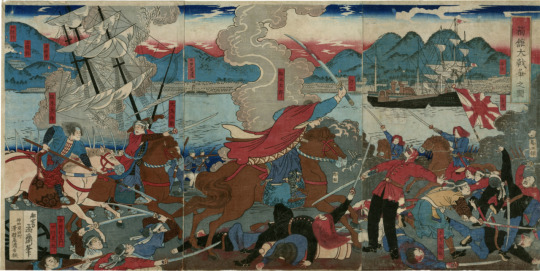
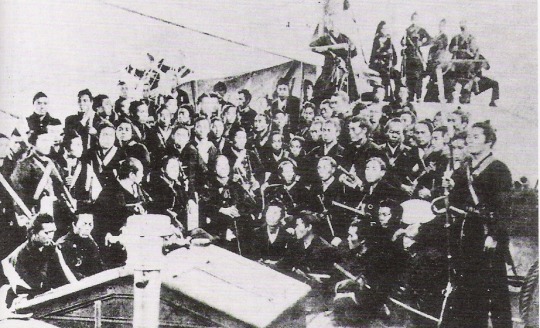
The Battle of Hakodate (箱館戦争, Hakodate Sensō) was fought in Japan from December 4, 1868 to June 27, 1869, between the remnants of the Tokugawa shogunate army, consolidated into the armed forces of the rebel Ezo Republic, and the armies of the newly formed Imperial government (composed mainly of forces of the Chōshū and the Satsuma domains). It was the last stage of the Boshin War, and occurred around Hakodate in the northern Japanese island of Hokkaidō.
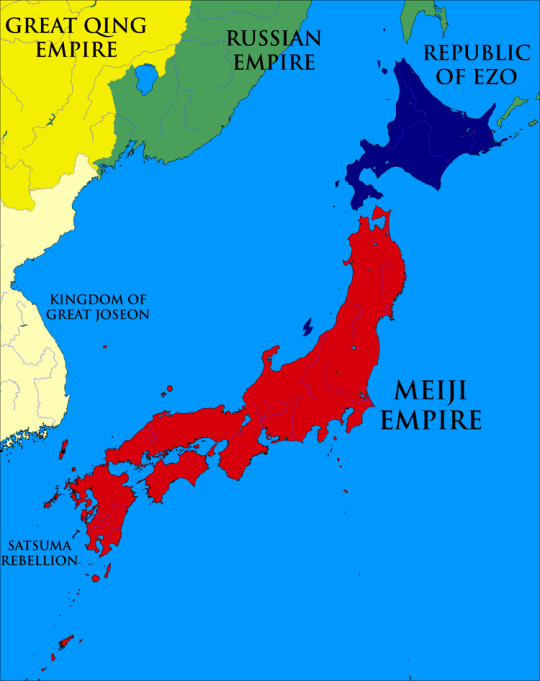
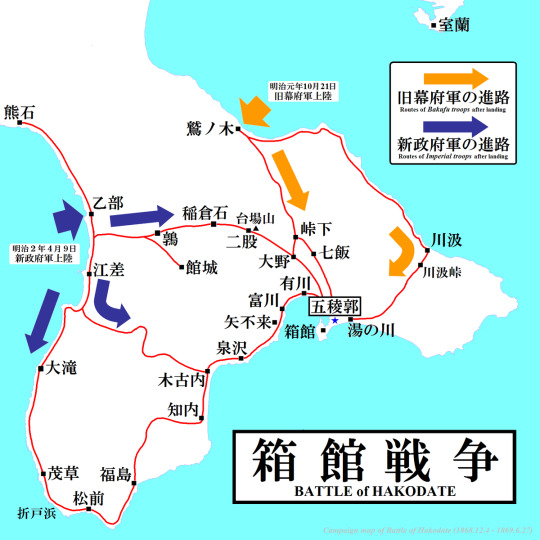
The Imperial troops, numbering 7,000, finally landed on Hokkaidō on April 9, 1869. They progressively took over various defensive positions, until the final stand occurred around the fortress of Goryōkaku and Benten Daiba around the city of Hakodate.
Japan's first major naval engagement between two modern navies, the Naval Battle of Hakodate Bay, occurred towards the end of the conflict, during the month of May 1869.[1]
After having lost close to half their numbers and most of their ships, the military of Ezo Republic surrendered to the Meiji government on June 27, 1869.
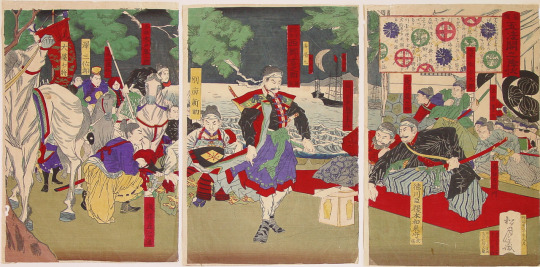
The battle marked the end of the old feudal regime in Japan, and the end of armed resistance to the Meiji Restoration. After a few years in prison, several of the leaders of the rebellion were rehabilitated, and continued with brilliant political careers in the new unified Japan: Enomoto Takeaki in particular took various ministry functions during the Meiji period.

The new Imperial government, finally secure, established numerous new institutions soon after the end of the conflict. The Imperial Japanese Navy in particular was formally established in July 1869, and incorporated many of the combatants and ships which had participated in the Battle of Hakodate.
2 notes
·
View notes
Link
A detailed description of the Battle of Ezo, and how Hijikata tried to take over an enemy battleship by pretending to be American.
20 notes
·
View notes
Text
Translation of the PASH interview with M27's Director
I translated the interview with M27 Director Nakaoka Chika in PASH's April issue, as well as a few of the questions from the Scriptwriter Ookura Takahiro's interview. (Raw from the DCEN Discord.)
Key new information:
There's a scene that reveals why Kudo Shinichi and Kaito Kid look similar.
They decided to save Hakodate's best nightscape for an "important scene" (that isn't the Kid vs. Heiji swordfight). Additionally, Heiji will be saying an impactful line, and Nakaoka would like everyone to pay attention to Heiji's feelings leading up to him saying that line.
Per Nakaoka, Aoyama said that Okita and Kazuha know each other's faces, but aren't any closer than that. (Also, they have a conversation in the movie.)
Ookura is fond of Ran's role because of the way Ran enthusiastically supports Kazuha in the movie.
Translation under cut.
Preparing For Battle
What will be the plot of Detective Conan: The Million-Dollar Pentagram, which will be released next month…?
Gather hints from Director Nagaoka and scriptwriter Ookura’s stories!
A new truth regarding Kid, not yet shown in the original series, will be revealed.
As the release date of The Million-Dollar Pentagram draws ever nearer, new information drops by the day. What no doubt drew everyone’s attention the most was the tagline on the main visual- “At last, it will be revealed. ‘The truth regarding Kid.’” It appears as though in this movie, a “secret” that has yet to be shown in the original series will be revealed.
Please also draw your attention to Hattori Heiji, who stars in a movie for the first time in seven years, and how his confession to Kazuha will turn out. We hope you look forward to the release! ♪
Staff Interview 01: Director Nakaoka Chika
Q. When did you receive the offer to be the director of Detective Conan: The Million-Dollar Pentagram?
It was after The Scarlet Bullet (Detective Conan Movie 24) ended. Aoyama-sensei was the one to nominate me- it was already decided that Kid would appear at that time, and as he quite enjoyed The Fist of Blue Sapphire (Detective Conan Movie 23), he likely nominated me thinking “Well, it’s a Kid movie, so better go with Nakaoka!” I definitely felt the pressure, but I was also determined to do my best.
Q. In this movie, Hattori will be part of the main cast along with Kaito Kid, correct?
I learnt that Heiji would be a main cast member at the same time I learnt that Kid would appear, but my first thought was- “So they meet at last!” In the original manga and the anime series, Kid and Heiji have shared the stage in Fairy Lips (Anime Ep. 983-984 Kid vs. Koumei: The Targeted Lips). But in the movies, even if they’ve appeared in the same one, they’ve never met without Kid being in disguise. So I realized that this would be the first time they would actually talk.
Q. Their swordfight, as shown in the currently-revealed previews, left quite the impression on me.
As the movie takes place in Hakodate, and Hijikata Toshizō appears as an original character, we decided fairly early on to include a swordfight. Aside from the Kid vs. Heiji swordfight revealed in the PVs, there’s actually so many swordfights you might think- isn’t this a bit much?! We did decide, “Let’s go with something related to katanas,” but honestly I never thought we’d show so many katanas in the end (lol).
Q. Please tell us the inside scoop on the Kaito Kid vs. Hattori swordfight scene.
We decided we wanted to have an action scene somewhere where you could see Hakodate’s nightscape, but we wanted to save the well-known nightscape for an “important scene”. So, we had Kid and Heiji fight with a lesser-known nightscape as their backdrop.
Q. As the movie takes place in Hakodate, Hokkaido, did you go visit in person?
Yes! It was my first time in Hokkaido, so I was very excited for it. And when I arrived, I truly felt once again that Hakodate valued history deeply, from the way they kept old buildings in great repair. I understood at a glance why Hijikata-san valued the land so deeply. It also felt rather special that Mount Hakodate was visible no matter where you were.
Q. What are you keeping in mind with this movie as you bring Edogawa Conan to life?
I keep in mind that it’s always Edogawa Conan who discovers the important things when it comes to mysteries. While Kid and Heiji are the main cast in this movie, I’d still like the protagonist to play a big part. Also, this is just related to Conan, but the way Takayama Minami-san would act out Conan’s expressions left a big impression on me. She would question my lines and ask things like, “What is Conan feeling in this scene?” And her feedback was all amazingly sharp- it made me think, “I’d expect no less from Conan-kun!” (lol). Sometimes my heart would thump as I answered.
Q. Could you tell us what you think we should focus on in the movie?
Definitely the katanas. As the main motif, they appear quite a bit, and I investigated them quite a bit- I put lots of care into it. There’s also a scene where Heiji says a line I’d want everyone who loves Detective Conan to hear. His entire atmosphere changes when he says that line- it was so amazing, I couldn’t stop smiling after the recording. Please look forward to it! I’d also appreciate it if you’d pay attention to Heiji’s feelings until that point.
Aside from that, there’s a scene in the PV where Heiji is shocked at Kaito’s bare face- please don’t miss the scene that reveals why, “Hey, don’t Shinichi and Kid look kinda similar?”
Q. Please tell us what left an impression on you during your interactions with the movie staff.
It was my first time meeting Kanno (Yugo)-san, but I truly felt that all of the songs he composed for the movie were superb. The Million-Dollar Pentagram has aspects to it that resemble a period drama, so I requested that he include taiko drums in his pieces. Then, he created music reminiscent of a festival that hadn’t appeared much in Detective Conan before. It felt very fresh to me when I heard it for the first time.
Q. Did your experience with The Fist of Blue Sapphire and The Scarlet Bullet help you with this movie?
When it comes to the Detective Conan movies, the usual suspects are always present on the production crew. So I feel as though I’ve gotten the hang of things like everyone’s areas of expertise, such as what scenes would be best drawn by which person. So I always made sure to give the storyboarders and animators scenes that would allow them to bring out their own unique talents. I also think the way the Detective Conan movies use a surprising amount of CGI is also one of its unique points. We use so much, it makes me think- “I don’t think a normal series would use so much?” But it’s because it’s been used for so many years that when we join CGI with animation, we can judge that, “Ah, this much is alright.” I believe that The Million-Dollar Pentagram has managed that balance as well.
Q. On the flip side, what did you do for the first time?
We had a designer named Hama Yuuto-san join us for this movie. When I met him on a different project, I thought that he drew designs that made a big impression. He’s produced various designs in a superb manner for The Million-Dollar Pentagram as well. For example, I consulted with Hama-san regarding things such as the stained glass and Higashikubo Eitatsu’s katana’s [scabbard(?)]. I think it’s best to consult a professional designer when designing something rather than an amateur trying it, and as a large number of katanas appear in this movie, it also allowed us to differentiate them.
Q. Who would you like us to focus our attention on in this movie?
Among the guest characters, I would say Kawazoe. He’s a bit clumsy and scatterbrained, but he’s skilled at information gathering despite that. He was a fun character to bring to life. Among the main cast, I would say Heiji and Kazuha. What will happen with their love story? I’m sure there’s plenty wondering about that!
Q. On a side note, when the teaser visual was revealed, Okita went trending on X (formerly Twitter.) I think many look forward to his part in the movie.
We decided to include Okita as the movie takes place in Hakodate and includes Hijikata, but he’s certainly a super cool character. Though I can’t say much as it’s before release, there is a scene where Okita and Kazuha talk to each other. But I think in the original series they haven’t talked properly before, so I didn’t know how close they were- that’s why I asked Aoyama-sensei for information on what their relationship is like. He responded, “They would recognize each other, but that’s all.” I kept that in mind while having them talk.
Q. Finally, please leave a message to our readers waiting with anticipation for the release.
I believe you’ll see the movie in different ways if you watch it from a different perspective each time- for example, first from Kid’s perspective, then from Heiji’s, then again from Kazuha’s. Also, you’ll only be able to experience the mystery of where the treasure is the first time you see the movie, so I would appreciate it if you played the part of one of the detectives and tried to solve the mystery as you watch.
Staff Interview 02: Scriptwriter Ookura Takahiro
T/N: I was too lazy to translate the whole thing by the time I got to this point, but have a few of the questions I was actually interested in.
[...]
Q. So that’s why Okita will be appearing in the movies for the first time?
While I can’t speak in detail about it, in the end I appreciated that Okita was part of the movie cast. Please look forward to it.
Q. Speaking of first appearances, Detective Kawazoe will be appearing as an original character in this movie. How did you create his character?
As the movie takes place in Hakodate, we decided to have Inspector Nishimura appear- that’s when we realized that he would have a subordinate, something like what Detective Takagi is to Inspector Megure. Since we couldn’t make Inspector Nakamori into his subordinate, we created Detective Kawazoe.
Also, before we decided on the treasure-finding plot, we initially had him as a spy that Public Safety had placed into their ranks. There were some characters we created because we’d need more police officers if Public Safety made an appearance as well. But even after the plot changed and Public Safety no longer played a part, Detective Kawagoe remained. This is the inside scoop on his character creation.
[...]
Q. What other characters would you like us to focus on in this movie?
While Heiji and Kazuha are the main cast, personally I’d choose Ran. I must apologize, but I haven’t been able to make Ran shine in the scripts I’ve been in charge of until now. But in this movie, I felt it was easy to bring Ran to life. She supports Kazuha full steam ahead. I personally was a big fan of that (lol).
[...]
#detective conan#dcmk#detective conan movie 27#meitantei conan#detco#the million-dollar pentagram#hyakumandoru no michishirube#detective conan m27#honestly given the focus on hijikata toshizou my money is on shinichi and kaito and okita all having a shared bakumatsu era ancestor#my translations
245 notes
·
View notes
Text
actually the story of the Azuma is really interesting for the sheer amount of anachronisms it is subjected to.
So the confederacy tried to buy a ship from the french government so they could do privateering raids on american shipping (like classic piracy).
The confederate representative spoke directly to Napoleon III of France (The real napoleon's idiot nephew), because it was illegal to sell weapons to the confederacy under french law and they figured it would be easier for the emperor to circumvent french law than anybody else, which was true.
The ship was constructed under the false name of Sphynx, to encourage rumors it was intended to be sold to Egypt (A protectorate of the ottoman empire, successor state to the roman empire (or at least that's what they said)).
However it was eventually caught as an intended sale to the confederacy, so the sale was cancelled and it was instead sold to Denmark under the name Stærkodder, as a combatant in the Second Schleswig War (Otto Von Bismarck's efforts to unite Germany). Before it could be used for doing war things with, Denmark lost.
After Denmark lost, they sold Stærkodder to the Confederacy in early 1865, who renamed it to the CSS Stonewall. Before it could be actually used for doing war things with, The Confederacy lost. It was then sold to Cuba (which was still a Spanish colony!), and then again to the US. Here's a photograph of it around this time.
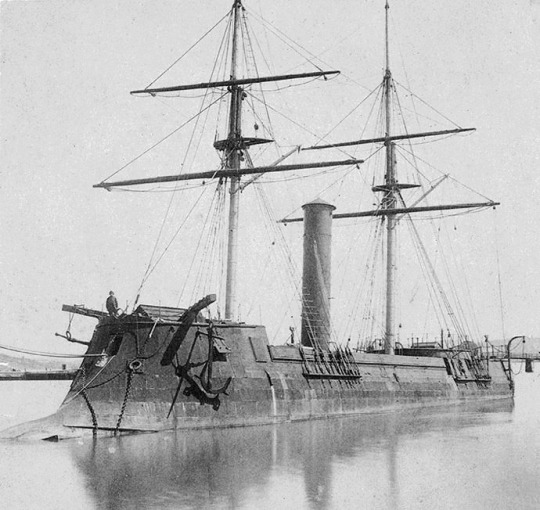
At this point the Tokugawa Shogunate purchased the Stonewall, seeking to reinforce their navy. They renamed it Kotetsu (Ironclad). And buddy. You're not gonna believe what happens next. Before the Tokugawa government could use it, the Boshin War started, and. Shockingly. The Tokugawa Shogunate lost the war.
Instead, it was sold to the Shogunate's opponent in the Boshin War, The Meiji Government (who gave it its final name, Azuma), where it was used in the battle of Hakodate to defeat the remnants of the shogunate navy. Here's a sketch of it during this battle.

So the ship was sold by a Napoleon to the Danish fighting Otto Von Bismarck, who then sold it to the Confederacy in the american civil war, who then ended up selling it to the Tokugawa Shogunate in the japanese civil war! This one ship was used by danish monarchists, american cowboys, and japanese samurai, all within 5 years!
#not worm#DW historical trivia corner#history#that last paragraph is a generalization but like i'm sure there was at least one cowboy and one samurai aboard at some point#I don't actually know much about the meiji restoration so there may be some innacuracies there#by the way my only source here was wikipedia. sorry?#it's just a generalized overview so it's not too big of a deal#and besides wikipedia is actually pretty reliable nowadays
7 notes
·
View notes
Photo

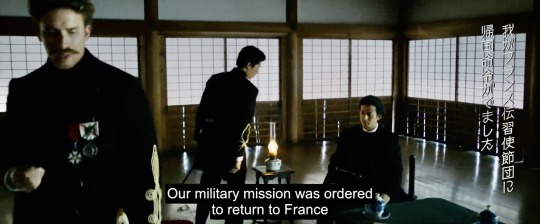
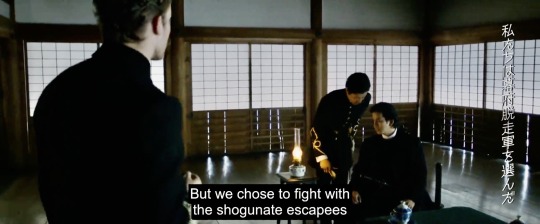
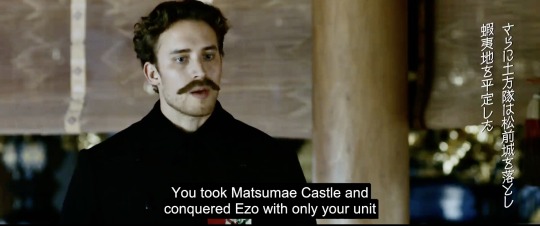
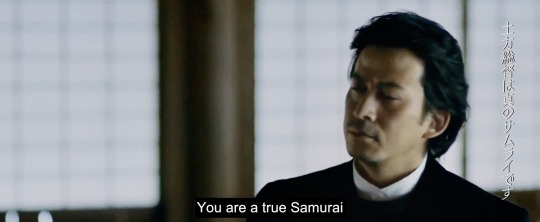
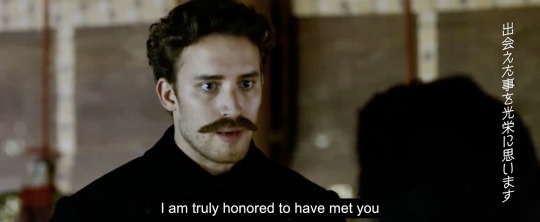

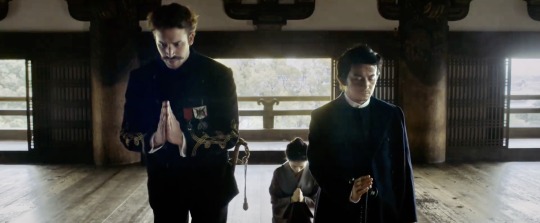

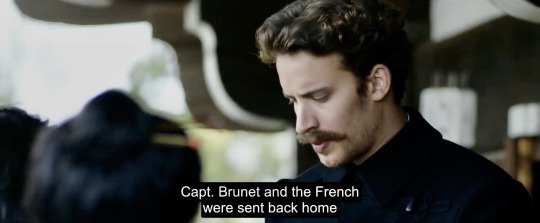
Baragaki: Unbroken Samurai (2021)
Captain Jules Brunet was sent to Japan in 1867 to train the Japanese in Western Military Tactics after the Shogunate requested help from Napoleon III. When the Imperials took control, he was ordered to return to France but he chose to stay and fight with the Samurai against the Imperials.
After the fall of Aizu, he fled to Hokkaido with the Samurai survivors where a last major battle of the Boshin War took place at Hakodate. He did his best but the Imperials outnumbered and outgunned the Samurai. He managed to return home and wrote a memoir where he spoke highly of the Shinsengumi.
He inspired Tom Cruise's character of Nathan Algren in The Last Samurai .
#baragaki unbroken samurai#baragaki#unbroken samurai#jules brunet#jonas bloquet#boshin war#the last samurai#shinsengumi#japan#japanese movies#j movie#jmovie#historical movies#samurai
48 notes
·
View notes
Note
HIJIKATA PROPAGANDA TIME BECAUSE MY MAN IS TOO POWERFUL AND SEXY TO BE BEATEN IN THE FIRST ROUND BY A RWBY CHARACTER
1. He was the former Vice Commander of the Shinsengumi, which were basically a bunch of BADASS Samurai.
2. In real life, he died in 1869 during the Battle of Hakodate, BUT in the anime he lived and was imprisoned as a prisoner of war. Man did NOT want to die.
3. He escaped prison in the most badass way possible. He was in a prison transfer with a bunch of other prisoners when he coordinated an escape with all of the prisoners and absolutely SLAUGHTERED the prison guards.
4. He has so much sexy swagger energy that people go doggy eyes and literally would DIE just so he could live.
5. old man yaoi. (his best friend, Nagakura Shinpachi, has always been by his side ever since they were boys, and Nagakura has always supported him no matter what)
6. please vote for him. he didnt fight against the entire new Meiji Government just to be obliterated by a RWBY character.
He does sound quite sexy and powerful, but also to be fair, she is a really iconic RWBY character
(in the future please try to not bring down the other characters or sources in your propaganda)
15 notes
·
View notes
Text
Hisoka’s Thoughts on Hakodate Division

Kotan Anchikar
“An Ainu chief? My knowledge is limited, I’ll be honest. I’m still pretty new to the Hokkaido area. Plus, the Ainu are pretty reclusive all things considered. I just can’t imagine that this man has it easy. Why is he getting dragged into the D.R.B. of all people? Aren’t there other people in Hakodate city who could have taken his place? I can’t help but feel bad for him. Unless he’s thinking positively and taking this as an opportunity to do something big… But I really doubt he feels that way.”
Ted Bridges
“Hm? Bridges? I think I’ve seen that name in the cellar before… T-The owner of the ranch I work at has a collection of alcohol he’s gotten from people he’s connected with in one way or another. I only remember that name because so many of my seniors have gotten scolded for trying to open that barrel up, among the other rare bottles and kegs that are off-limits. I think even Rikiya-san had some bottles of this guy’s product too. Wonder what makes it so valued… Maybe I can ask Asato-kun if he can bribe his grandma to send me some. Hope it’s strong…”
Kokomi Morozov
“A pro snowboarder? You’re insane if you think I’ve met with someone like her. Plus, I don’t think anyone I know even knows about her… And why she’s in Japan. Why did she choose Hakodate? I don’t remember there being a ton of ski resorts when I went to the Hakodate Racecourse… What do I know though? Maybe the mountain has some good spots.”
Kuma no ie
“This is a comfy looking team when you look at them all together. It kind of reminds me of Asato-kun’s team. Being so close to their representative city’s culture and minding their own business… How awful that they are being dragged into a battle with people like me. But hey, so long as people aren’t aware of my past, I can probably pass as a wholesome team like Kume no ie. …Maybe.”
#hypmic#hypnosis mic#hypnosis microphone#hypmic oc#hypnosis mic oc#hypnosis microphone oc#obihiro division#veiled vanguard#hisoka tetsumasu#hakodate division#kuma no ie#kotan anchikar#ted bridges#kokomi morozov
5 notes
·
View notes
Text
aira is probably in history class like “I’m an idol! why do I have to memorize all these warlords!” but he forgets that every single guy at the ensemble square loves to compare being an idol to going to war so tatsumi will be trying to explain something to him by saying “it’ll be like our battle of hakodate” and aira will be like “huh??”
7 notes
·
View notes
Text
1869-Hijikata Toshizō,(土方歳三) Japanese commander

Hijikata Toshizō (土方 歳三, May 31, 1835 – June 20, 1869) was a Japanese warrior. As Vice-Commander (副長, Fukucho) of the Shinsengumi, he resisted the Meiji Restoration and fought to his end.
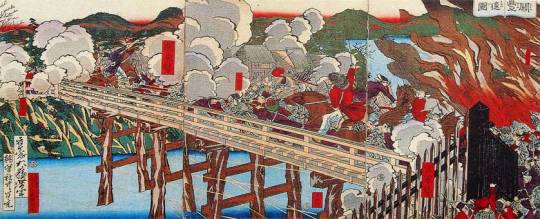
Following the Boshin War in 1868, Kondō and Hijikata led the Shinsengumi in their final battles against the new government and fought in the Battle of Toba–Fushimi in January 1868. The Shinsengumi returned to Edo and was later reformed into a unit known as the Kōyō Chinbutai (甲陽鎮撫隊, "Pacification Corps") and departed from Edo for Kōfu Castle on March 24 upon orders to suppress the uprisings there. On March 29, 1868, Kondō, Hijikata and the Kōyō Chinbutai resisted an attack by the Imperial forces at the Battle of Kōshū-Katsunuma for about two hours but lost, and they were scattered and fled to Edo.

In October 1868, Hijikata and Ōtori Keisuke led Shogunate forces to occupy the fortress of Goryōkaku in the Battle of Hakodate, and continued to eliminate local resistance. When the short-lived Ezo Republic was founded in December, Hijikata was made a Deputy Defence Minister (Vice-minister of the Army).[6] Imperial troops continued to attack by land and sea.

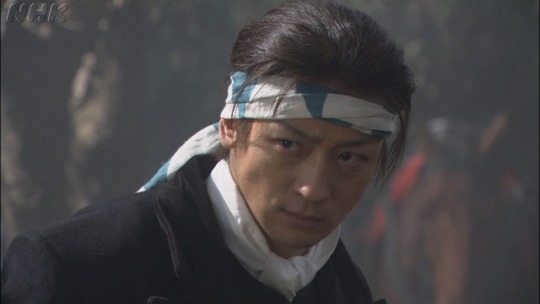
During the Battle of Hakodate, the final battle of the Boshin War, Hijikata summoned his 16-year-old page, Ichimura Tetsunosuke on June 14 (lunar calendar May 5), 1869, to a private room in an inn. There, he entrusted Ichimura with a death poem, his katana, a letter, a photograph of himself, and several strands of his hair. Ichimura was instructed to bear them to the home of Hijikata's brother-in-law Satō Hikogorō in Hino. The death poem entrusted to Ichimura reads:
Though my body may decay on the island of Ezo, my spirit guards my lord in the East.

In the final conflict of the revolution, on June 20 (lunar calendar May 11), 1869, Hijikata was killed near the Ippongi Kanmon (一本木関門) by a bullet that shattered his lower back while leading his troops on horseback. His body was later claimed by Koshiba Chōnosuke and others.
#Jun.20.1869#date of death#Hijikata Toshizō#土方歳三#Japanese commander#Battle of Hakodate#history today
0 notes
Note
I am trying to find info on a friend of the Shinsengumi . He was known for having lost his hand in battle . He went all through the Boshin war only to be so badly wounded at Goryokaku that Enemoto had to overdose him on morphine .
I believe he was of higher rank than Hijikata but the two got on well . Sorry I can’t even remember his name?
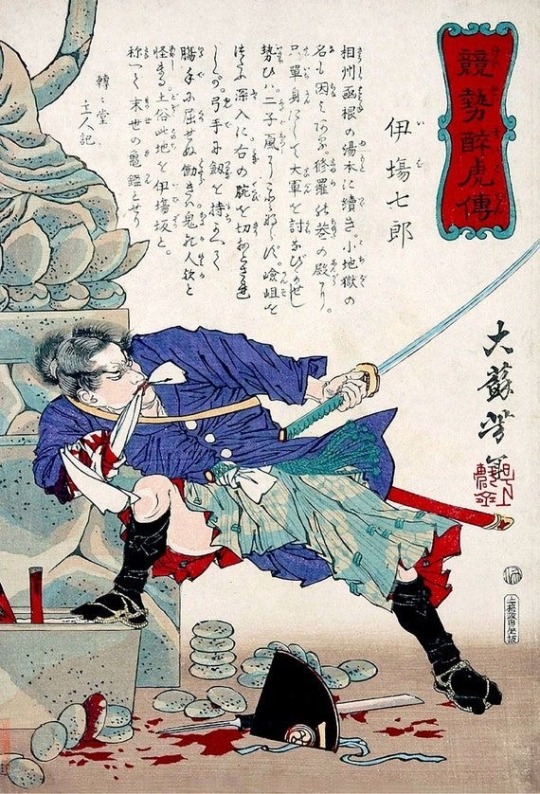
That would be Iba Hachiro.
You could read more about him here and here.
He was friends with Hijikata back when they were students in Edo (source), and he used to visit the Shieikan Dojo "for fun every three days or so". Here's an interesting anecdote:
Kondo Isami’s adoptive father, Kondo Shusuke, the third generation master of Tennen Rishin-ryu, gave up his position to Kondo Isami and lived a retired life. He often liked to go listen to kodan storytellers.
After listening to the story, when he returned to the Shieikan, he would gather Kondo Isami, Hijikata Toshizo, Okita Souji, Nagakura Shinpachi, “Iba Hachiro who came for fun every three days or so”, and others, and reenact the three parts by himself over bowls of mori soba noodles.
While everyone was eating soba, Kondo Shusuke would talk about the contents of the story of the day.
Everyone would listen quietly as they ate, but Iba Hachiro, who finished eating first, would go off somewhere, and then one or two people would leave their seats.
In the end, only Kondo Isami was still listening to Shusuke, and the two of them would laugh to each other’s face. This was an anecdote introduced by Fukuchi (Fukuchi Ouchi, a student at the Shieikan who wrote a book “剣豪秘話”).
(source)
In Hakodate, Iba became the head of infantry entrusted with the 1st Regiment and 2nd Battalion, consisting of guerrilla forces, the Shinsengumi, and the Shogitai (source). Hijikata was the General of the Kando Army (source), in other words, the commander-in-chief of the ground forces (source). I'm not sure who was ranked higher 😅
Tamara Ginnosuke, who was there during Iba's death, provided an eyewitness account many years later:
at the end of the Boshin War in Hakodate, Iba Hachiro was offered sake poisoned with morphine by Enomoto. He laughed and drank it heartily to end his own life.
(source)
This site contains a very detailed biography of Iba Hachiro. It's in Japanese, but I might translate it later :)
18 notes
·
View notes
Text
Kuma no ie Team Dynamics

Kotan is considered by the team to be their ace in the hole since his ability is perhaps the most dangerous out of the trio. Therefore, though he dislikes it, his teammates often keep him in the back until the situation calls for it. As stated, his ability is dangerous to his adversaries, as it drastically increases his stats and makes him immune to any adverse effects. Thus, eliminating Kotan first should be his opponent's plan going into battle.
Ted, not surprisingly, is the group's tank. Besides the fact that he is the only one out of the group who has seen actual battle, his large body makes him a tough wall to bypass. As if that wasn't bad enough, his ability also increases his already high defense, making him even more of a threat. He can also switch over to attack if need be, but most of the time he stays put in his spot unless needed.
Kokomi functions as the team's support, as her ability gives the team a free hit should it connect to her opponent. Though she is a novice when it comes to rapping, her small yet athletic body allows her to dodge or evade most blows that come her way. Also, for some reason, she feels more empowered when she is standing and fighting alongside Ted.
— Kotan
Ted to Kotan is a friend of both his family and tribe, as well as his surrogate father. After the solitary woodsman saved the life of a bear cub from a group of poachers, Kotan's tribe welcomed the former soldier as a member of the Ainu tribe. Whenever the pressures of being the chieftain are too much for Kotan, he often heads to Ted's chalet to either talk to him or simply bask in the glory of nature with the rough mountain man. As stated, Kotan views Ted as something of a father figure and knows that he can always go to him whenever he needs some manly advice. In Rap Battles, despite being the leader, Kotan usually adheres to Ted's advice, following his orders.
Kokomi to Kotan is a friend of a friend, being introduced to her by Ted, after he had rescued her. At first, Kotan was not exactly sure what to think about the Russian snowboarder, finding her mannerisms and behavior a bit off-putting, especially when she was drunk. But after viewing her ability to ride the snow on a board, Kotan and his people started viewing the young woman in a new light. Thus, Kotan always makes sure to include her whenever his people have a festival or a ritual, hoping that, in time, she will decide to become an honorary member of the Ainu people.
In Rap Battles, Kotan always tries to protect Kokomi from any harsh or fatal blows that come her way. He also often switches roles with her when it is needed.
— Ted
Kotan to Ted is his friend and an honorary member of his tribe. At first, Ted did not care to get to know the people living in the valleys below his mountain, as his only priority was keeping both himself and his son safe from harm. But within time, Ted eventually got to know Kotan and the Ainu people and found their way of life both pleasing and tranquil. After routing some poachers that planned to kill an innocent bear cub, the Ainu people made Ted a member of the tribe, which he considers an honor.
After Kotan was made chieftain, Ted now does all he can to assist the young boy with his role. He doesn't mind when Kotan comes to his home to get away from his role. Though Ted won't assist with every problem Kotan and his people have, when it comes to the sanctity and security of the city of Hakodate and the mountains, the Ainu people are glad to have a former soldier on their side. In Rap Battles, Ted always makes sure to protect Kotan, using his large body and strength to keep him from harm. And despite not being the leader, Ted is quick to relay orders to Kotan, which the Ainu chief quickly follows.
Kokomi to Ted is a friend to both him and his son. The two met after Ted saved Kokomi from a bear who, unfortunately, was awoken after Kokomi had accidentally wandered into its den. After saving her, he showed her the safe spots on which she could snowboard and ski. Though he didn't expect to see her again after that (he figured she'd be too scared to come back), the woodsman was surprised to see the snowboarder surfing on the white mountains once more. After several nights of letting her stay in his chalet, he agreed to let the Russian snowboarder rent a room in his home. Though he won't deny that he enjoys her presence, a part of Ted is worried that Kokomi may, unintentionally, be replacing his former wife.
In Rap Battles, like Kotan, Ted does his best to protect Kokomi from any blows. And like him, he is also quick to relay any orders or advice to her, which she follows.
— Kokomi
Kotan to Kokomi is her friend, after being introduced to him by Ted. Though she had heard of the Ainu people before, the Russian snowboarder had never actually encountered them. As such, when she first met Kotan, she unintentionally insulted him and his people, which he disliked immensely. It was only thanks to Ted's timely arrival that no hostilities occurred (Kokomi didn't exactly know what she had said wrong). However, after more time getting to know his people and understanding their ways of life, an acquaintanceship eventually formed between the Ainu chieftain and the Olympic snowboarder.
Also, when she can, Kokomi agreed to teach some of the children and adults how to snowboard and ski, which they figured would help them when it came to hunting. Though there are aspects of the Ainu people that Kokomi still doesn't fully understand, Kotan is eager to teach her. In Rap Battles, Kokomi works alongside Kotan and switches spots with him when she is injured, and vice-versa. She often likes to use her ability first and then have Kotan activate his to eliminate their opposition quickly.
Ted to Kokomi is her rescuer and the man she secretly loves and adores. After he had rescued her from a bear that she had unintentionally disturbed, Kokomi bore witness to this giant of a man, and fell in love with him at first sight. Though her reasons for returning to the mountains were simply to snowboard and ski, in truth, she really returned in hopes of meeting Ted again. After several nights of allowing her to stay in his chalet, she eventually took the leap and asked if she could live with him, which surprised him. Though he was skeptical, he eventually relented. The two now live together, and Kokomi is working hard every day in hopes that she can finally work up the nerve to confess her feelings to the lonely woodsman.
In Rap Battles, Kokomi fights alongside Ted, which invigorates her. She follows any advice he gives, but will sometimes disobey when it involves him taking a hit for her, which she hates.
#hypmic#hypmic oc#hypnosis mic#hypnosis mic oc#hypnosis microphone#hakodate division#kuma no ie#kotan anchikar#ted bridges#kokomi morozov#relationships#headcanons#team dynamics
9 notes
·
View notes
Text
kojima visiting hakodate right now, do you think he's doing naval battle studies and the battle of miyako b-is tackled to the ground and restrained-
2 notes
·
View notes
Note
I'm joining the other anons to once again THANK YOU for all the hardwork! You are who is keeping the fandom alive because otherwise nobody would know what's going on in the manga. Speaking of which, I can't believe we are so close to reach the final stage of the story of the Shinsengumi because once the battle of Aizu ends we'll jump to Ezo again and with that we'll have a ticking clock to the moment of the prologue with Hijikata sending Tetsunosuke away and then his death in the battle of Hakodate....considering the manga started in 1999 and went through changing editorials and hiatuses, is amazing how far Chrono-sensei has come and now he is so close to the end! I think PMK is one of the few Shinsengumi manga who has portrayed the whole story of the Shinsengumi from Ikedaya to Ezo, and my biggest wish and that of the fans is that once the manga is done we'll have a proper anime reboot like many other old series are having right now that animates the story from beginning to end. Sorry the long message but I got carried away lol. Once again thank you!
Thanks so much for this sweet message, anon! I'm always so glad that I can bring PMK content to English-speaking fans even if this isn't a very large fandom, haha. Also, I know! We're really getting close to the end now. Hard to believe that this wild ride that's lasted for over 20 years could be ending soonish, huh? It's going to be strange once it's all wrapped up, like saying goodbye to an old friend.
Prayer circle for a proper anime reboot for sure, though; I feel like we'd all love to see movie-quality animation set to the entire proper story!
9 notes
·
View notes
Text
Over a century ago he abandoned the Gotei Thirteen. This is an immutable fact. His reasons, however justified, did not change the reality of the situation. For those with a militant background they would understand such an idea as 'abandoning your post.' It means to leave a duly appointed position, leaving those whom should be your allies in jeopardy without guard or leadership. It is tantamount to cowardice in the eyes of some and an action which no amount of repentance will wipe away the dishonor. Even now as he stands as a bulwark against the enemy which is harassing and bleeding the Gotei in a manner which he has never seen before.
Some have forgotten him. They have forgotten the glories he has won for them, and they have forgotten the shame he brought upon them. It matters not to him. His single minded resolve is focused on ensuring those who he regarded as family makes it through this day. Even if they would not wish the same for him. The tight corridors of the Seireitei make for brutal fighting, and quick decisive action. His eyes are drawn to one encounter after another, and his throws himself into the fray with a viciousness that few can match.
He hacks and cleaves and crushes as needed. He fights with a ferocity that is honed from a lifetime of war. Not battle, war. His heart has grown callous to the suffering of men while at odds against them. Brief flashes of the jungles of Vietnam come to his mind. The screams of dying men. His mind thinks of the field of Antietam. His body recalls the pains of Hakodate. This blood war is the same, except this time he has grown wise to the ways of the world. His heart is callous but it is not closed off to the suffering of those around him. A quick, merciful, death is the only reprieve he may offer.
He stands unbroken with his shadow stretched over the kidou healers of the Gotei. His uniform is tattered and well-worn. But it is cared for. It has been resewn numerous times, just as his flesh has been mended. Among the crowd only one recalls his visage, and their eyes are wide. An old friend? Maybe. They are flabbergasted as Hayden turns his face forward, walking forward to the next battle. More lives to save.
He falters slightly. A slight stutter step. Barely perceivable. The damage is acclimating. As he turns a corner out of sight, he collapses to a knee. His Zanpakatou pressed into the hard stone beneath him. He's tired. Limbs heavy. He's forgotten how long he's been doing this. The sound of footsteps draw his eyes upwards, to a figure which now stands but a few meters away.
Burnt-orange hair, how strange.
@auburniivenus
4 notes
·
View notes
Text
Events 5.4 (before 1950)
1256 – The Augustinian monastic order is constituted at the Lecceto Monastery when Pope Alexander IV issues a papal bull Licet ecclesiae catholicae.
1415 – Religious reformers John Wycliffe and Jan Hus are condemned as heretics at the Council of Constance.
1436 – Assassination of the Swedish rebel (later national hero) Engelbrekt Engelbrektsson
1471 – Wars of the Roses: The Battle of Tewkesbury: Edward IV defeats a Lancastrian Army and kills Edward of Westminster, Prince of Wales.
1493 – Pope Alexander VI divides the New World between Spain and Portugal along the Line of Demarcation.
1626 – Dutch explorer Peter Minuit arrives in New Netherland (present day Manhattan Island) aboard the See Meeuw.
1686 – The Municipality of Ilagan is founded in the Philippines.
1738 – The Imperial Theatrical School, now known as Vaganova Academy of Russian Ballet, was founded under the reign of Empress Anna. It is the first ballet school in Russia and second in the world.
1776 – Rhode Island becomes the first American colony to renounce allegiance to King George III.
1799 – Fourth Anglo-Mysore War: The Battle of Seringapatam: The siege of Seringapatam ends when the city is invaded and Tipu Sultan killed by the besieging British army, under the command of General George Harris.
1814 – Emperor Napoleon arrives at Portoferraio on the island of Elba to begin his exile.
1814 – King Ferdinand VII abolishes the Spanish Constitution of 1812, returning Spain to absolutism.
1836 – Formation of Ancient Order of Hibernians
1859 – The Cornwall Railway opens across the Royal Albert Bridge linking Devon and Cornwall in England.
1869 – The Naval Battle of Hakodate is fought in Japan.
1871 – The National Association, the first professional baseball league, opens its first season in Fort Wayne, Indiana.
1886 – Haymarket affair: In Chicago, United States, a homemade bomb is thrown at police officers trying to break up a labor rally, killing one officer. Ensuing gunfire leads to the deaths of a further seven officers and four civilians.
1904 – The United States begins construction of the Panama Canal.
1910 – The Royal Canadian Navy is created.
1912 – Italy occupies the Ottoman island of Rhodes.
1919 – May Fourth Movement: Student demonstrations take place in Tiananmen Square in Beijing, China, protesting the Treaty of Versailles, which transferred Chinese territory to Japan.
1926 – The United Kingdom general strike begins.
1927 – The Academy of Motion Picture Arts and Sciences is incorporated.
1932 – In Atlanta, mobster Al Capone begins serving an eleven-year prison sentence for tax evasion.
1942 – World War II: The Battle of the Coral Sea begins with an attack by aircraft from the United States aircraft carrier USS Yorktown on Japanese naval forces at Tulagi Island in the Solomon Islands. The Japanese forces had invaded Tulagi the day before.
1945 – World War II: Neuengamme concentration camp near Hamburg is liberated by the British Army.
1945 – World War II: The German surrender at Lüneburg Heath is signed, coming into effect the following day. It encompasses all Wehrmacht units in the Netherlands, Denmark and northwest Germany.
1946 – In San Francisco Bay, U.S. Marines from the nearby Treasure Island Naval Base stop a two-day riot at Alcatraz Federal Penitentiary. Five people are killed in the riot.
1949 – The entire Torino football team (except for two players who did not take the trip: Sauro Tomà, due to an injury and Renato Gandolfi, because of coach request) is killed in a plane crash.
0 notes
Text
I promised in my previous post that I would take the time to write about Iba Hachiro because there’s so little about him in English, so here’s a “today I learned” about Hachiro...
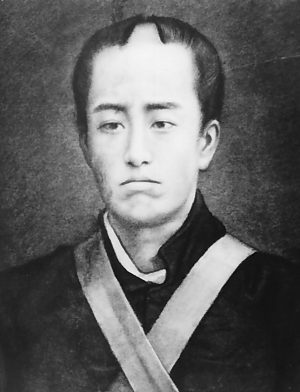
Iba Hachiro was born in 1844, making him the same age as Okita Soji, Saito Hajime, and Todo Heisuke. (Apparently, 1844 was an unlucky year to be born if you were going to be any good with a sword...)
Hachiro was the eldest son of Iba Gunbei and his second wife, Maki. Gunbei’s Shingyoto-ryu swordsmanship school in Okachimachi was one of the four largest dojos in Edo, and as the eldest son, Hachiro would have been expected to eventually take over the school as its next master.
However, Hachiro was often sick as a child and did not start training at the dojo until he was well into his teens, much later than most samurai boys of his time, who generally started training earnestly at a dojo around age 9 or 10.
Instead of swordsmanship, Hachiro focused on classical Chinese studies and Western learning, and his father appointed his adopted son, Hidetoshi, to be his dojo’s successor.
(We don’t know a lot about Hidetoshi or the circumstances in which he was adopted, but it’s possible that the family was concerned their own heir, Hachiro, may not live to adulthood.)
When Hachiro finally started training with the sword, he proved to be a prodigy and in 1864, at age 20, he became part of the shogun’s guard alongside 50 other talented swordsmen.
This led him to accompany Tokugawa Iemochi to Kyoto.
While he was in Kyoto, Hachiro kept a journal detailing the local sights he visited and the different foods he tried - he was a bit of a “foodie.”
After shogun Iemochi’s death, the unit to which Hachiro belonged was restructured and became the Yugekitai, which later fought in all major battles of the Boshin War, including Toba-Fushimi, Ueno, and Hakodate.
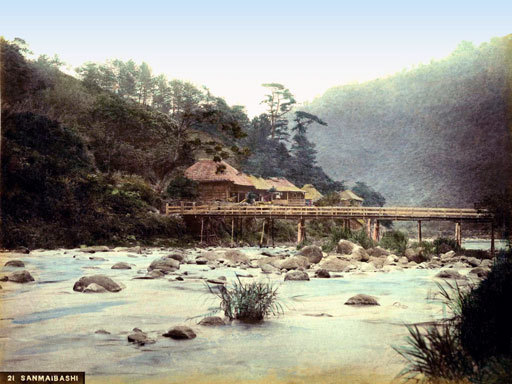
In summer 1868, Hachiro was leading a group of 130 Yugekitai soldiers when they clashed with a much larger force of the new government army in Yumoto, an important strategic location on the Tokaido road connecting Odawara and Hakone.
Toward evening, the fighting moved onto Sanmaibashi bridge (pictured above in a slightly later photograph), a narrow wooden structure connecting the two banks of the Hayagawa river.
Here, Hachiro was shot at the waist, which wasn’t a deep injury but caused him to be distracted when an enemy soldier from the Odawara domain, Totaro Takahashi, approached and tried to cut him down.
Hachiro instinctively brought up his left arm to protect himself, perhaps hoping that his armored sleeve might catch the edge of the sword, and lunged forward to stab Takahashi, killing him. But the damage was done - Takahashi’s sword had cut Hachiro just above the wrist.
Kamakichi, Hachiro’s juusha (attendant) later remembered Hachiro’s hand was dangling by the skin and about two inches of bone was seen protruding from the wound, but Hachiro said it didn’t hurt at all. (He was probably in shock at this point if he was messing with his mostly-severed hand - one source said he was “scraping at the bone with a knife” and explaining that it didn't hurt...)
Kamakichi carried him to a nearby inn where he was treated by Hayashi Tadataka’s doctor who cut through the rest of the skin to remove the hand, stopped the bleeding, and bandaged it.
A few days later, he was treated more extensively by Dr. Shinohara aboard Enomoto Takeaki’s ship, Asahi Maru, which served as a hospital ship.
(On a side note, the Japanese navy’s next hospital ship, which saw service from 1928 to 1944, was also called Asahi Maru.)
Shinohara saw it necessary to amputate Hachiro’s arm at the elbow, presumably because the original wound had become infected. However, when he started preparing the anesthetic, Hachiro refused, reportedly saying: “How can I sleep if someone is cutting my bones!” In the end, Hachiro’s surgery was done without anesthetic.
While Hachiro’s arm was healing, he realized he could still use his sword one-handed, but became concerned that he may no longer be able to use a rifle, so before the wound had even fully healed he set up targets and worked on figuring out how to rest the gun on what remained of his arm.
Meanwhile, the main force of the Yugekitai had already left for Oshu and Hachiro and the remaining troops did not set out to follow them until the beginning of October, sailing aboard the Mikaho Maru, one of the ships in Enomoto Takeaki’s fleet.
However, the fleet was caught in a storm and Hachiro’s ship ran aground at Inubosaki (Choshi).
Of the troops aboard the Mikaho Maru, 13 were killed and the survivors decided to make their way to either Edo or Tsushiura, but most of them were quickly captured by the new government army.
Hachiro attempted to commit seppuku (I’ve not found a very clear explanation as to why except that he was “regretful”) but was stopped by Nakane Kotei, an infantry officer, and then hidden by Seki Shinpachi until transport could be found for him aboard an American ship to Hakodate where he could rejoin the shogunate forces.
On Ezo, Hachiro led his troops into battle and fought valiantly until he was seriously injured (again...) during the battle of Kikonai when he was shot in the chest.
Although he was taken to Hakodate hospital, medical technology at the time was not advanced enough to treat him and there was little doctors could do.
When the wounded were transported from Hakodate hospital during the withdrawal, hoping to make it to Goryokaku, he never complained, even though just drawing a faint breath was incredibly painful.
Eventually, Enomoto Takeaki offered him morphine mixed with sake and Hachiro used it to end his own life in June 1869 (May 12 or May 15 by the lunar calendar), just prior to the surrender of Goryokaku. He was 26 years old.
#history notes#historical notes#history reference#historical reference#history research#historical research#today I learned#TIL#Iba Hachiro#shingyoto-ryu#battle of hakodate#goryokaku#enomoto takeaki
44 notes
·
View notes